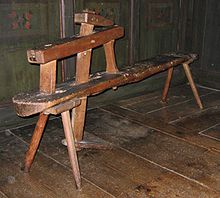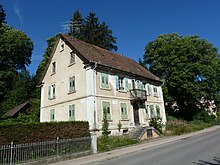Oskar Spiegelhalder
Oskar Johann Spiegelhalder (* 15. October 1864 in Lenzkirch ; † 17th December 1925 ibid) was director of the corporation for Uhrenfabrikation Lenzkirch and collectors of Black Forest folk art , including Black Forest clocks , Black Forest glass , glass paintings , straw weaving , Schneflerei , rustic furniture and tools.
Life
Youth, education
Oskar Spiegelhalder was born on October 15, 1864 in Lenzkirch as the oldest of three children. Shortly after his birth, Oskar lived with his grandmother in Falkau for a year . In 1871 the father Joseph Spiegelhalder (1837–1901) bought his own house in Lenzkirch for the family. The siblings Hedwig and Ernst were born in 1866 and 1869. The Spiegelhalder family was one of the wealthy Lenzkirch families. The children received piano and drawing lessons as well as private lessons in French. After elementary school in Lenzkirch, Oskar Spiegelhalder attended the higher civil school in Freiburg im Breisgau and the higher commercial school in Stuttgart .
Occupation: watch manufacturer
As the oldest son, he was supposed to follow in his father's footsteps and complete a commercial apprenticeship. During his apprenticeship in Paris and London, Oskar worked for various business partners of the Lenzkircher watch factory. After one year of military service in Constance , Oskar Spiegelhalder joined the corporation for watchmaking in Lenzkirch in 1886 , where he soon worked in the field. In the course of his work he made many trips. During his stays in major European cities, Spiegelhalder got to know a wide variety of contemporary forms of culture. He visited art exhibitions and museums, theaters and opera houses, but also variety and circus performances. In 1893 Oskar Spiegelhalder was appointed to the board of directors of the Lenzkircher watch factory and was its director from 1908 to 1909.
family
In 1895 Spiegelhalder married Hermine, b. Jaeger. Their first and only daughter Maria Theresia was born in 1898. She died childless in 1983.
Collections
Just a few years after Spiegelhalder had started to travel long distances as a sales representative of the Lenzkircher watch factory, he began to build up the first collection: "My collecting activities on folklore of the high Black Forest began occasionally with excursions, which I took in 1889 to the nearby & further away from Lenzkirch. But it wasn't until 1890, after I happened to get to know the collection of the Association for German Folk Costumes & Home Furnishings in Berlin Klosterstrasse, that I began to collect systematically. ” The systematic of his collection is initially strong due to this same Berlin model, which later became the Museum for Germans Folklore , definitely.
First collection
Spiegelhalder stored the objects he was collecting in his parents' house, with whom he was also living at the time. In 1894 the folklorist Elard Hugo Meyer visited the granary . He recognized the quality of the collected objects and aroused the interest of the city of Freiburg in Spiegelhalder's objects through his semi-publicly articulated recognition. After some negotiations, 1,225 exhibits were finally acquired in 1896 for the then Freiburg Municipal Collections for a purchase price of 16,000 marks . Today the collection is kept in the Augustinermuseum Freiburg.
Second collection
Spiegelhalder immediately started collecting again after the sale, he deposited the objects in the same place. In 1906 he selected a few pieces and presented them publicly in his own house in Lenzkirch. He sold this permanent collection with 1,342 exhibits in 1909 for 33,000 Marks to the Baden state, which transferred it to the “United Grand Ducal Collection” in its “Badische Trachten und Hausgeräte” department. The focus of the Karlsruhe Spiegelhalder collection lay in the area of the commercial and industrial history of the Upper Black Forest (watchmaking, glass blowing and straw weaving). To date, only about 800 objects have survived due to war damage, which are housed in the collections of the Badisches Landesmuseum in Karlsruhe .
Third collection
With the remaining pieces from his parents' house, Spiegelhalder immediately filled the empty rooms in his own house again and opened them up again to the public. He expanded this third collection considerably over the next few years. As early as 1910/11 he offered it to the city of Freiburg for sale, but the city refused. In the twenties he intensified his sales activities again. After some negotiations with the Baden state and various cities, his widow finally sold the 2,610 exhibits together with his private library to the city of Villingen for 60,000 Reichsmarks in 1929 . Today it can be viewed in the Franciscan Museum in Villingen-Schwenningen .
One of Oskar Spiegelhalder's contemporaries was the concert singer Helene Siegfried-Aichele (1867–1966), who built the Hüsli near Grafenhausen -Rothaus in the old Black Forest house style; she also collected old Black Forest folk art.
Spiegelhalder's collection activity was the subject of a research project funded by the Volkswagen Foundation at the Franciscan Museum in Villingen-Schwenningen from 2012 to 2015 .
Villa Spiegelhalder
Spiegelhalder acquired his house on Freiburger Strasse in 1903. It is located right next to the house built in 1848 by the manufacturer and later MP Paul Tritscheller . The building had been empty since the late 1990s. Rainwater had been seeping into the interior through the leaky roof for several years, and the cellar stairs had collapsed. The community Lenz church had EAFRD requested -means to the building, as well as the nearby Gasthaus zum Löwen, acquire and to demolish. In the summer of 2016, however, it became known that the previous owner from Freiburg had sold the Spiegelhalder villa to a private buyer from Bollschweil, whose later bid was higher than that of the municipality. The new owner announced that they would renovate it and make it habitable again over the next two to three years. [outdated]
Fonts
- The glass industry in the Black Forest . In: Communications from the Association of the Royal Collection for German Folklore in Berlin 3, 1908
literature
- Peter Paul Albert : The Black Forest collection from Oskar Spiegelhalder in Lenzkirch. Two centuries of Black Forest house industry and folk life. In: Journal of the Society for the Promotion of History, Antiquity and Folklore from Freiburg, the Breisgau and the adjacent landscapes, Vol. 25, 1909, pp. 91-124 ( digitized version ).
- Black Forest glass and glassworks . Inventory catalog of the Franziskaner Museum Villingen, Black Forest Collection, City of Villingen-Schwenningen, Villingen-Schwenningen, 1976.
- Raimund Adamczyk: Oskar Spiegelhalder 1864–1925. Villingen-Schwenningen, City of Villingen-Schwenningen, 1989.
- Brigitte Heck: On the genesis of folklore collections. Oskar Spiegelhalder and his contribution to museology. Unpublished master's thesis, Freiburg 1989.
- Anita Auer, Reinhold Krämer: With the eyes of the collector. Oskar Spiegelhalder's Black Forest Collection . Villingen-Schwenningen, Franciscan Museum, 2000.
- Michaela Haibl, Gudrun M. König, Anita Auer, Christina Ludwig (ed.): The passions of the collector. Oskar Spiegelhalder as a science amateur . Villingen-Schwenningen, 2015.
Web links
Individual evidence
- ↑ in: Deutsche Uhrmacher-Zeitung , Volume 32, 1908, p. 277, preview in the Google book search
- ^ Manuscript "Black Forest Collection by Oskar Spiegelhalder in Lenzkirch", Villingen-Schwenningen City Archives 2.42.1-1.
- ↑ Brigitte Heck: On the history of the origins of folkloric collections. Oskar Spiegelhalder and his contribution to museology . Master's thesis Freiburg 1989, p. 42ff.
- ↑ Franziskanermuseum and TU Dortmund start a research project on Oskar Spiegelhalder. In: villingen-schwenningen.de. February 29, 2012, accessed on May 2, 2020 (city administration press release).
- ↑ Anita Auer: The Black Forest Collection Oskar Spiegelhalders (1864-1925). Immutable cultural monument or expandable collection approach? ( Memento of March 7, 2013 in the Internet Archive ) (PDF; 22 kB) Website of the German Museum Association. Retrieved July 9, 2013
- ↑ Ralf Morys: Former inn "Löwen" is being torn down - Villa Spiegelhalder will be preserved. Badische Zeitung, August 25, 2016, accessed on May 2, 2020 .
| personal data | |
|---|---|
| SURNAME | Spiegelhalder, Oskar |
| ALTERNATIVE NAMES | Spiegelhalder, Oscar |
| BRIEF DESCRIPTION | Watch manufacturer and collector, local researcher |
| DATE OF BIRTH | October 15, 1864 |
| PLACE OF BIRTH | Lenzkirch |
| DATE OF DEATH | December 17, 1925 |
| Place of death | Lenzkirch |




